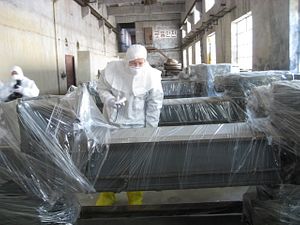The United States needs to give up the fantasy that North Korea is ever going to completely hand over all of its nuclear knowledge or know-how. If the U.S. is serious about de-weaponizing the North Korea, or the DPRK, then it should seize the current momentum and use commercial nuclear energy as a tool to accomplish that. Providing North Korea with proliferation-resistant nuclear reactors for civilian purposes is a win for all involved. Such a step could build trust and mitigate proliferation concerns.
In 1994, the United States signed the Agreed Framework, in which it agreed to (with an international consortium) provide the DPRK with two proliferation-resistant light water reactors. The Agreed Framework fell apart in 2002, a few years after Kim Jong Il has tested a Taepodong missile and the existence of uranium enrichment program become public. But the world has changed since the Agreed Framework’s failure. In his 2018 New Year’s Day speech, Kim Jong Un, who succeeded Kim Jong Il in 2011, relayed that North Korea had achieved its decades-long goal of possessing a nuclear deterrent and now wanted to enhance the socialist economy and raise its people’s standard of living. This opens a space for a new U.S.-DPRK relationship.
Eliminating North Korea’s nuclear weapons and missile programs will be neither easy nor fast, but it is possible. In May, Siegfried S. Hecker, Robert L. Carlin and Elliot A. Serbin of Stanford released a technically-informed denuclearization roadmap that could achieve the denuclearization of the DPRK within a decade. Establishing civilian nuclear energy in North Korea will not only aid in the denuclearization process, but also lift up the people by providing stable power. Stable power, which is necessary for refrigerators, washing machines, and sustained running water, means an immediate improvement in the lives of average Koreans.
Given the DPRK’s stated desire to add nuclear energy to its country’s energy mix, and the single-mindedness with which it has shown itself capable of going after goals, it’s fair to assume that regardless of US policies it will obtain civilian nuclear power – either from domestic development or from China. North Korea has already signaled its interest in using nuclear energy to end the rolling blackouts that continue to plague the country. After the failure of the Agreed Framework, the North began a domestic program to develop light water reactors for energy. 38 North, a website dedicated to North Korea analysis, reported in February that satellite imagery showed the experimental light water reactor at the Yongbyon Nuclear Scientific Research Center to be nearing operational status.
Working with Pyongyang to build a civilian nuclear energy program is one way to accomplish the de-weaponization of the DPRK. Keeping North Korean nuclear scientists engaged in the positive, productive, and peaceful pursuit of electrifying their country is in everyone’s best interest. China and Russia are both experiencing high success rates in building reactors abroad, through aggressive government-led financing campaigns, while the U.S. nuclear industry seems to be slowing down. U.S. nuclear expertise could build meaningful and enduring scientific partnerships and help fortify the global nonproliferation regime.
Before these peaceful reactors can materialize significant progress, beyond what has already been agreed upon has to occur. For starters, the Kim Regime needs to follow through on the agreement it made at the most recent inter-Korean summit to permanently dismantle its main nuclear reactor site, and allow international inspectors at the closing of a main missile test site and launch pad. Likewise, the United States needs to be prepared to take steps towards providing the security guarantees agreed upon at the Singapore Summit.
The use of proliferation-resistant reactors, as well as North Korea joining the appropriate international organizations would do wonders to build up trust, and the Comprehensive Test Ban Treaty (CTBT) is an easy place to start. It aligns with the regime’s self-proclaimed halt to nuclear testing, and would demonstrate its willingness to join the international community. Signing the CTBT could be a stepping stone to lead to the accession of North Korea to the Nonproliferation Treaty (again), the acceptance of nuclear safeguards, the IAEA’s Additional Protocol, and beyond. From a regional perspective, transforming the DPRK’s nuclear programs from military to civilian would help mitigate security concerns.
When it comes to denuclearization, Washington must embrace creative and flexible thinking. North Korea will eventually have nuclear energy, so the question is whether Americans will shape and profit from that process in a way that brings about a safer world or cede that opportunity to China and Russia.
Kelli Kennedy is a Master’s candidate at the LBJ School of Public Affairs at The University of Texas studying Politics and Security on the Korean Peninsula and in East Asia.

































